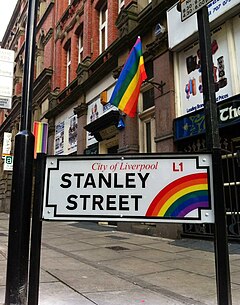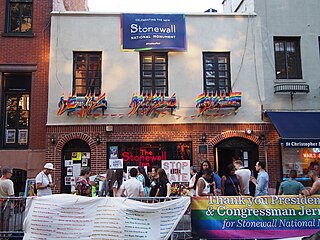
A gay village is a geographical area with generally recognized boundaries, inhabited or frequented by many lesbian, gay, bisexual, and transgender (LGBT) people. Gay villages often contain a number of gay-oriented establishments, such as gay bars and pubs, nightclubs, bathhouses, restaurants, boutiques and bookstores.

Canal Street is a street in Manchester city centre in North West England and the centre of Manchester's gay village. The pedestrianised street, which runs along the west side of the Rochdale Canal, is lined with gay bars and restaurants. At night time, and in daytime in the warmer months, the street is filled with visitors, often including LGBT tourists from all over the world. The northern end of the street meets Minshull Street and the southern meets Princess Street; part of the street looks across the Rochdale Canal into Sackville Gardens.

Gay Village is a neighbourhood delineated by St. Catherine Street East and Atateken Street in the Ville-Marie borough of Montreal.

A Dyke March is a lesbian visibility and protest march, much like the original Gay Pride parades and gay rights demonstrations. The main purpose being the encouragement of activism within the lesbian community. Dyke marches commonly take place the Friday or Saturday before LGBT pride parades. Larger metropolitan areas usually have several Pride-related happenings both before and after the march to further community building; with outreach to specific segments such as older women, women of color, and lesbian parenting groups.

Brighton and Hove Pride is an annual event held in the city of Brighton and Hove, England, organised by Brighton Pride, a community interest company (CIC) who promote equality and diversity, and advance education to eliminate discrimination against the lesbian, gay, bisexual and trans (LGBT) community.
The LGBT community has adopted certain symbols for self-identification to demonstrate unity, pride, shared values, and allegiance to one another. LGBT symbols communicate ideas, concepts, and identity both within their communities and to mainstream culture. The two most-recognized international LGBT symbols are the pink triangle and the rainbow flag.
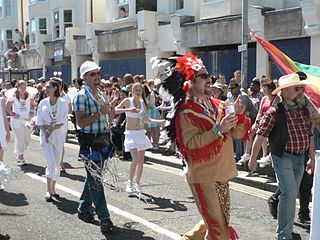
The LGBT community of Brighton and Hove is one of the largest in the United Kingdom. Brighton, a seaside resort on the south coast of England, is generally agreed to be the unofficial "gay capital" of the UK, with records pertaining to LGBT history dating back to the early 19th century.

Pride in London is an annual LGBT pride festival and parade held each summer in London, the Capital of the United Kingdom. The event, which was formally run by Pride London, is sometimes referred to as London Pride.

The rainbow flag is a symbol of lesbian, gay, bisexual, transgender, and queer (LGBTQ) pride and LGBTQ social movements. Other older uses of rainbow flags include a symbol of peace. The colors reflect the diversity of the LGBTQ community, as the flag is often used as a symbol of gay pride during LGBTQ rights marches. While this use of the rainbow flag originated in San Francisco, it is now used worldwide.

Gay pride or LGBT pride is the promotion of the self-affirmation, dignity, equality, and increased visibility of lesbian, gay, bisexual, and transgender (LGBT) people as a social group. Pride, as opposed to shame and social stigma, is the predominant outlook that bolsters most LGBT rights movements. Pride has lent its name to LGBT-themed organizations, institutes, foundations, book titles, periodicals, a cable TV station, and the Pride Library.

Stanley Street, in the centre of Liverpool, England, runs south between Dale Street and Whitechapel. As well as being home to numerous businesses ranging from estate agents to solicitors, some residents live in apartments in upper floors of some of the buildings. As part of the Big Dig, the southern half of the street between Whitechapel and Victoria Street was repaved in 2007, and is used as a taxi-rank serving Liverpool's central shopping district.
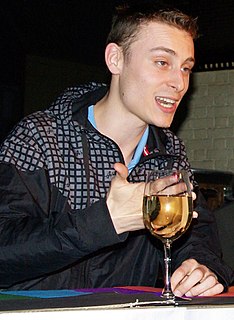
Thierry Schaffauser is a French sex worker, social activist, writer, and actor.

The Birmingham Gay Village is an LGBT district or "gaybourhood" next to the Chinese Quarter in Birmingham city centre, centred along Hurst Street, which hosts many LGBT-friendly businesses. The village is visited by thousands of people every week and has a thriving night life featuring clubs, sports bars, cocktail bars, cabaret bars and shops, with most featuring live entertainment including music, dancing and drag queens.

Liverpool Pride is a weekend-long festival to celebrate LGBT culture held annually at the Pier Head and Gay Quarter in Liverpool City Centre, England. The event is held on the closest weekend to 2 August, in commemoration of the death of Michael Causer, the young gay man who was murdered in the city in 2008, and has grown to become one of the largest free Gay Pride festivals in Europe with 2013's audience numbers reaching up to 75,000 people.
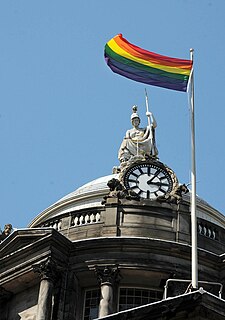
LGBT life in Liverpool, England is made up of persons who are either lesbian, gay, bisexual, or transgender/transsexual. Research commissioned by the North West Regional Development Agency approximated that there were around 94,000 LGBT persons living in the city's metropolitan area by mid-2009 - equivalent to the GLB population of San Francisco, making it the single largest minority group on Merseyside.

Homotopia is an international LGBTQ+ arts festival held annually in Liverpool, England. The festival takes place in late-October and throughout November every year and features a mixture of theatre, dance, film, photography, art, cabaret and debate at numerous venues across Liverpool, UK.
The LGBT community in London is one of the largest within Europe. LGBT culture of London, England, is centred on Old Compton Street in Soho. There are also LGBT pubs and restaurants in Earl's Court.
LGBT culture in Leeds, England, involves an active community of people who identify as lesbian, gay, bisexual, or transgender/transsexual. A BBC News Online article published in 2012 stated that, while Leeds City Council has not published statistics relating to the number of LGBT residents, the figure can be estimated at 10% of the overall population, which currently suggests a total of at least 77,000. The tenth year of the Leeds Pride march and celebration, held in 2016, was attended by over 40,000 people.
This is a timeline of notable events in the history of the lesbian, gay, bisexual and trans community in Manchester.
